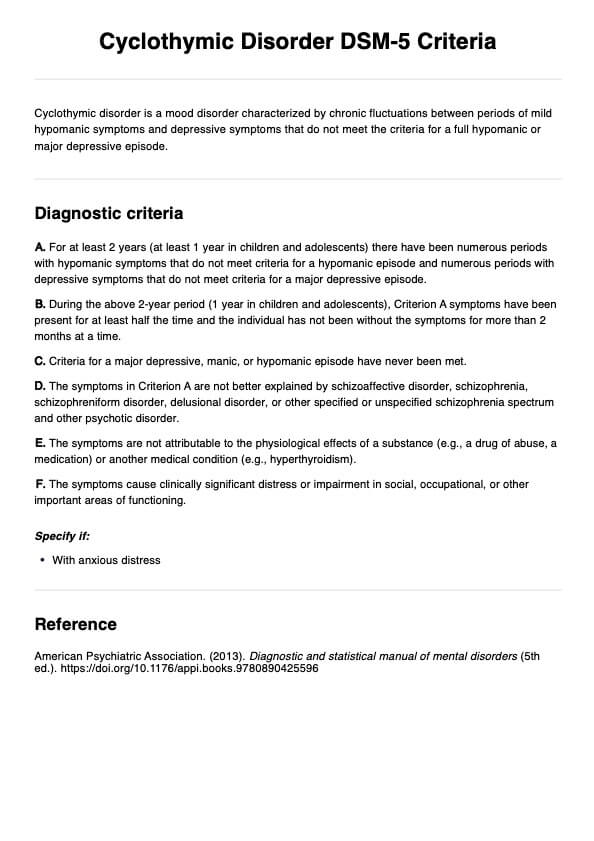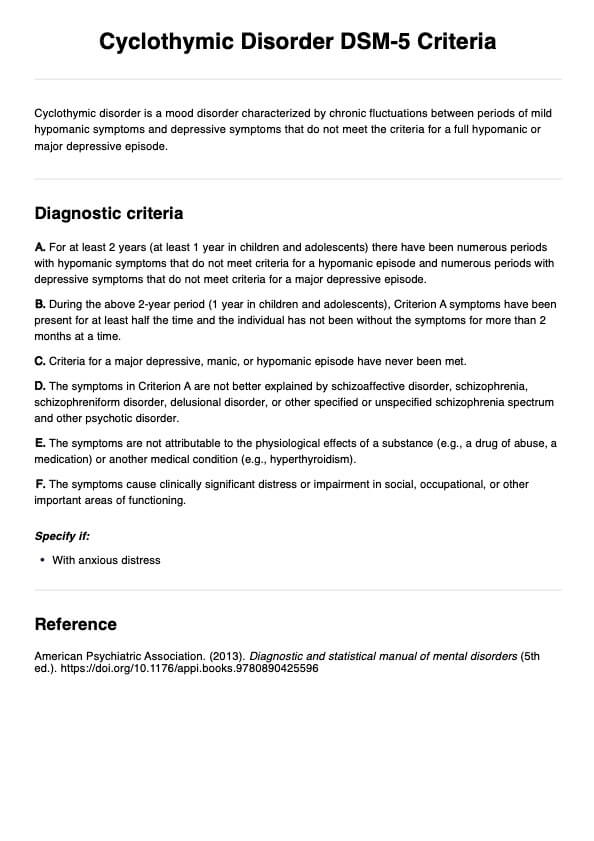Cyclothymic Disorder DSM-5 Criteria
Learn more about cyclothymic disorder—a mood disorder with chronic mood swings between hypomanic and depressed mood. Explore treatment and symptoms.


What is cyclothymic disorder?
Cyclothymic disorder is a chronic mood disorder characterized by numerous periods of hypomanic symptoms and depressive symptoms that do not meet the full criteria for bipolar disorders. It is considered a milder, but more chronic form of bipolar disorder. Hypomanic and depressive symptoms in cyclothymic disorder are less severe than those seen in bipolar I disorder and bipolar II disorder but can still cause significant distress.
The exact causes of the cyclothymic disorder are unknown, but risk factors include a family history of mood disorders such as major depressive disorder and bipolar disorders. Environmental factors, such as prolonged stress or traumatic experiences, can also contribute to its development.
Symptoms include fluctuating mood symptoms, with periods of elevated mood, increased energy, and activity (hypomanic) alternating with periods of depressive episodes characterized by low mood, fatigue, and hopelessness. According to the Diagnostic and Statistical Manual of Mental Disorders - 5 (DSM-5) (American Psychological Association, 2013), these mood fluctuations must persist for at least two years in adults.
Cyclothymic Disorder DSM-5 Criteria Template
Cyclothymic Disorder DSM-5 Criteria Example
How is cyclothymic disorder diagnosed?
Diagnosing cyclothymic disorder involves a thorough evaluation of the patient's mental health history and symptoms. According to the DSM-5, the diagnosis requires a chronic fluctuating mood disturbance lasting at least two years in adults (one year in children and adolescents) with periods of hypomanic and depressive symptoms that do not meet the criteria for a full hypomanic episode or major depressive episode (American Psychological Association, 2013).
The diagnostic process begins with a detailed clinical interview to assess the patient's mood swings, including elevated and low mood periods. During this period, the patient must not have been without symptoms for more than two months. A differential diagnosis is crucial to distinguish cyclothymic disorder from other mood disorders, such as bipolar disorder, borderline personality disorder, and affective disorders.
It is also essential to rule out substance use disorders, other related disorders, and sleep disorders that could explain the frequent mood swings. The diagnosis must ensure that the symptoms are not better explained by other mental disorders or the physiological effects of a substance or another medical condition.
The clinician must verify that the symptoms cause significant distress or impairment in social, occupational, or other important areas of functioning. Accurate diagnosis is pivotal for the effective treatment of cyclothymic disorder, which may include mood stabilizers and cognitive behavioral therapy.
Cyclothymia Disorder DSM-5 Diagnostic Criteria
The DSM-5 provides specific criteria for diagnosing cyclothymic disorder. These criteria ensure accurate diagnosis and differentiation from other mental health conditions.
A. For at least 2 years (at least 1 year in children and adolescents) there have been numerous periods with hypomanic symptoms that do not meet criteria for a hypomanic episode and numerous periods with depressive symptoms that do not meet criteria for a major depressive episode.
B. During the above 2-year period (1 year in children and adolescents), Criterion A symptoms have been present for at least half the time and the individual has not been without the symptoms for more than 2 months at a time.
C. Criteria for a major depressive, manic, or hypomanic episode have never been met.
D. The symptoms in Criterion A are not better explained by schizoaffective disorder, schizophrenia, schizophreniform disorder, delusional disorder, or other specified or unspecified schizophrenia spectrum and other psychotic disorder.
E. The symptoms are not attributable to the physiological effects of a substance (e.g., a drug of abuse, a medication) or another medical condition (e.g., hyperthyroidism).
F. The symptoms cause clinically significant distress or impairment in social, occupational, or other important areas of functioning.
Specify if:
- With anxious distress
Differences between the DSM-4 and DSM-5 criteria
The transition from DSM-IV-TR to DSM-5 included refinements in the criteria for cyclothymic disorder to improve diagnostic accuracy. Previously, cyclothymic disorder was not specifically delineated and often fell under broader bipolar and related disorders in DSM-IV-TR. The DSM-5 now provides more detailed criteria, emphasizing the chronic nature and specific symptomatology of hypomanic signs and depressive symptoms without meeting full episode criteria. These changes help clinicians distinguish cyclothymic disorder from other bipolar disorders and ensure more precise diagnoses.
How is cyclothymic disorder treated?
Cyclothymic disorder is treated through a combination of medication and talk therapy.
- Medication: Mood stabilizers such as lithium or anticonvulsants are often prescribed to reduce the severity of mood swings and help maintain stable moods. In some cases, antidepressants may be used cautiously to address depressed mood.
- Cognitive behavioral therapy (CBT): This talk therapy focuses on identifying and changing negative thought patterns and behaviors and is effective in managing mood changes.
- Lifestyle modifications: Establishing regular sleep patterns, maintaining a healthy diet, and engaging in regular exercise are crucial components of the treatment plan.
- Medication compliance: Ensuring adherence to prescribed medications is vital to prevent relapses and manage mood swings effectively.
- Monitoring and support: Regular follow-ups and support from healthcare providers help in tracking progress and making necessary adjustments to the treatment plan.
These treatment options aim to mitigate the symptoms of cyclothymic disorder, improve quality of life, and prevent the significant impairment caused by the disorder's insidious onset.
Reference
American Psychiatric Association. (2013). Diagnostic and statistical manual of mental disorders (5th ed.). https://doi.org/10.1176/appi.books.9780890425596
Commonly asked questions
Cyclothymic disorder is a mood disorder characterized by chronic fluctuations between periods of mild hypomanic symptoms and depressive signs that do not meet the criteria for a full hypomanic.
Diagnosis involves a thorough clinical evaluation, including a detailed history of mood symptoms, ruling out other mood ailments, and ensuring symptoms have been present for at least 2 years (1 year for children and adolescents) without a major depressive or manic episode.
Common symptoms include elevated mood, mood swings, and periods of depressed mood. These symptoms are less severe than those seen in full-blown hypomanic or depressive episodes.




















-template.jpg)



















































































